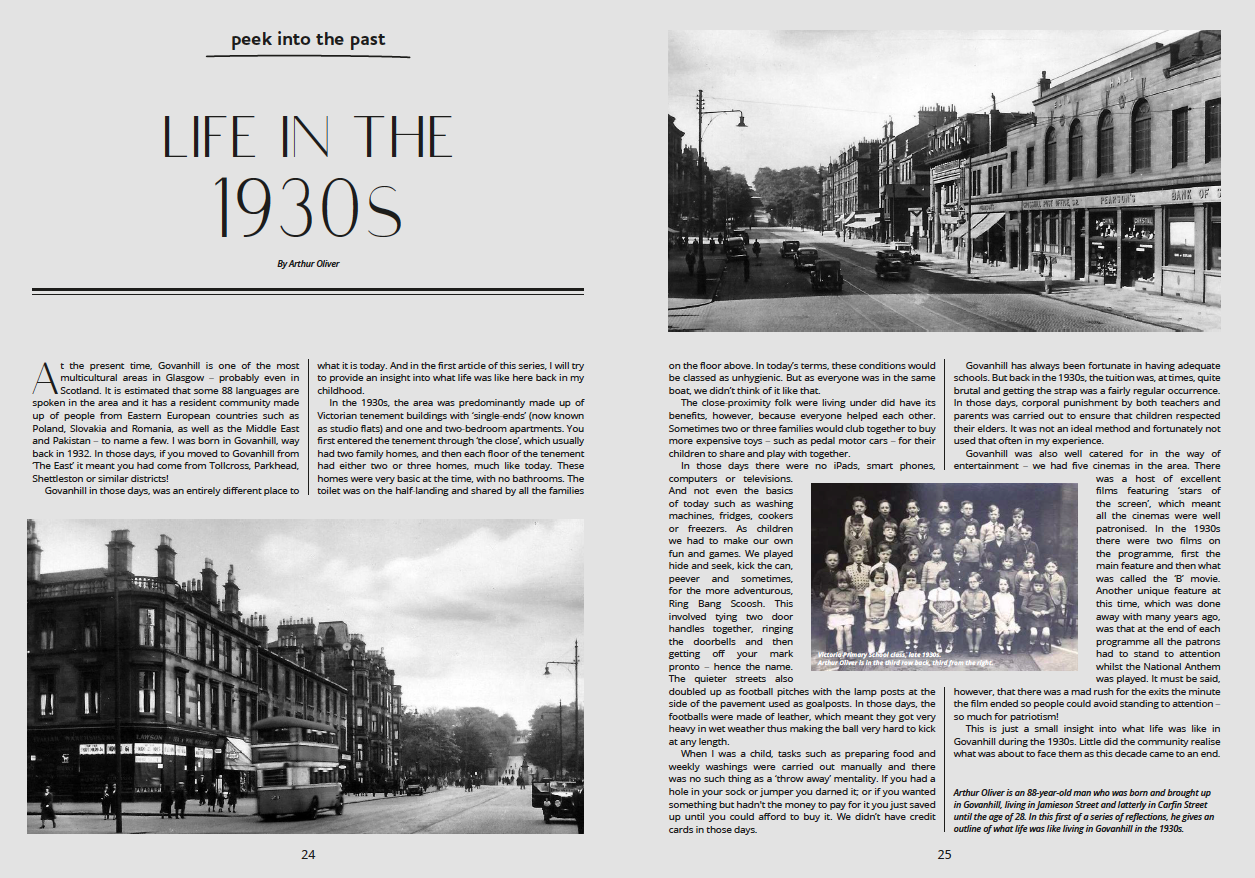Peek into the Past: Life in 1930s Govanhill
Now 88 years old, former journalist Arthur Oliver was born and brought up in Govanhill, living in Jamieson Street and latterly in Carfin Street until the age of 28. In this first of a series of reflections, he gives an outline of what life was like living in Govanhill in the 1930s.
by Arthur Oliver
At the present time, Govanhill is one of the most multicultural areas in Glasgow —probably even in Scotland. It is estimated that some 88 languages are spoken in the area and it has a resident community made up of people from Eastern European countries such as Poland, Slovakia and Romania, as well as the Middle East and Pakistan – to name a few. I was born in Govanhill, way back in 1932. In those days, if you moved to Govanhill from ‘The East’ it meant you had come from Tollcross, Parkhead, Shettleston or similar districts!
Govanhill in those days, however, was an entirely different place to what it is today. And in the first article of this series, I will try to provide an insight into what life was like here back in my childhood.
In the 1930s, the area was predominantly made up of Victorian tenement buildings with ‘single-ends’ (now known as studio flats) and one and two-bedroom apartments. You first entered the tenement through ‘the close’, which usually had two family homes, and then each floor of the tenement had either two or three homes, much like today. These homes were very basic at the time, with no bathrooms. The toilet was on the half-landing and shared by all the families on the floor above. In today’s terms, these conditions would be classed as unhygienic. But as everyone was in the same boat, we didn’t think of it like that.
The close-proximity folk were living under did have its benefits, however, because everyone helped each other. Sometimes two or three families would club together to buy more expensive toys — such as pedal motor cars — for their children to share and play with together.
Victoria Primary School class, late 1930s. Arthur Oliver is in the third row back, third from the right.
In those days there were no iPads, smart phones, computers or televisions. And not even the basics of today — such as washing machines, fridges, cookers or freezers. As children we had to make our own fun and games. We played hide and seek, kick the can, peever and sometimes, for the more adventurous, Ring Bang Scoosh. This involved tying two door handles together, ringing the doorbells and then getting off your mark pronto — hence the name. The quieter streets also doubled up as football pitches with the lamp posts at the side of the pavement used as goalposts. In those days the footballs were made of leather, which meant they got very heavy in wet weather thus making the ball very hard to kick any length.
When I was a child, tasks such as preparing food and weekly washings were carried out manually and there was no such thing as a ‘throw away’ mentality. If you had a hole in your sock or jumper you darned it; or if you wanted something but hadn't the money to pay for it you just saved up until you could afford to buy it. We didn’t have credit cards in those days.
Govanhill has always been fortunate in having adequate schools. But back in the 1930s the tuition was at times quite brutal and getting the strap was a fairly regular occurrence. In those days, corporal punishment by both teachers and parents was carried out to ensure that children respected their elders. It was not an ideal method and fortunately not used that often in my experience.
Govanhill was also well catered for in the way of entertainment — we had five cinemas in the area. There was a host of excellent films featuring ‘stars of the screen’ which meant all the cinemas were well patronised. In the 1930s there were two films on the programme, first the main feature and then what was called the ‘B’ movie. Another unique feature at this time, which was done away with many years ago, was that at the end of each programme all the patrons had to stand to attention whilst the National Anthem was played. It must be said, however, that there was a mad rush for the exits the minute the film ended so people could avoid standing to attention — so much for patriotism!
This is just a small insight into what life was like in Govanhill during the 1930s. Little did the community realise what was about to face them as this decade came to an end.
In Issue 2 of Greater Govanhill community magazine, Arthur will be sharing stories of Govanhill during the war years.
Become a supporter of Greater Govanhill to get a copy posted to your door.



